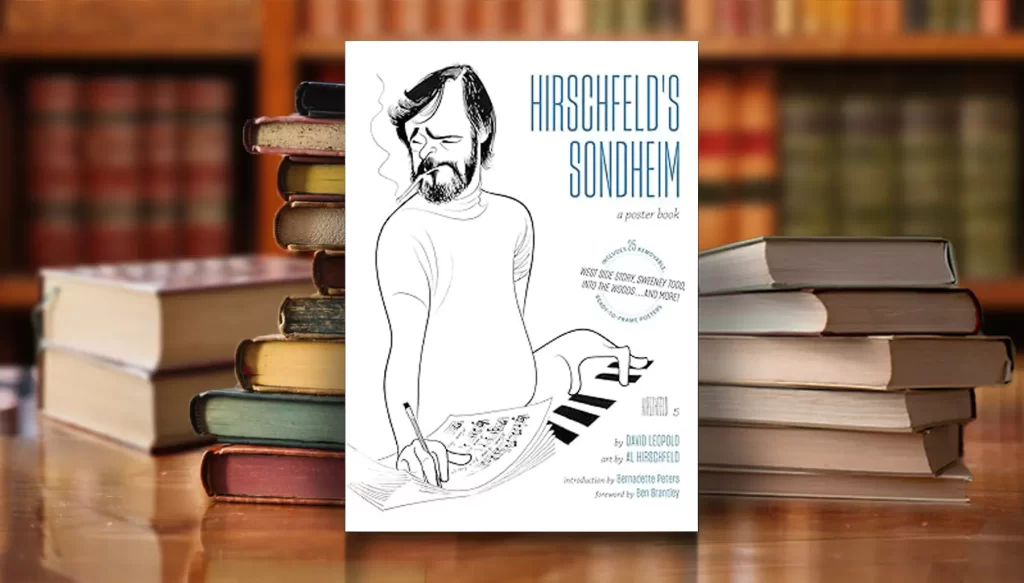“Hirschfeld’s Sondheim: A Poster Book”, David Leopold
Abrams Comicarts, New York, 2025.
Al Hirschfeld (Illustrator), Ben Brantley (Foreword), Bernadette Peters (Introduction).
Reviewed by Glenda Frank
We all miss them, Stephen Sondheim and Al Hirschfeld, two great souls who generated a unique synergistic partnership. Part of the magic of Hirschfeld’s Sondheim by David Leopold – with 25 removable, ready-to-frame posters by the inimitable Al Hirschfeld, a trove of sketches scattered throughout the book, an introduction by actor Bernadette Peters, and a foreword by critic Ben Brantley – is that it makes us happy as we trawl our memories.
David Leopold’s commentary celebrates both men with anecdotes and trivia about their lives, artistic processes, and the productions. The book cover shows the unshaven, cigarette-smoking musician at work, one hand on a keyboard, one holding a pencil and resting on a page of sheet music. It’s a private moment of creation, and we are invited in. And if finding the Ninas (Hirschfeld’s daughter’s name, hidden in the sketches) is your thing, there are five there, four of them, somehow fittingly, in the score. Turn a few pages and you will find a sketch of Hirschfeld at work, dipping a pen into the inkwell that lives in his brain.
A timeline takes us from Westside Story, 1957, through the revival of Into the Woods, 2002, with sketches for each. (Hirschfeld died in 2003.) Those for Getting Away with Murder (1996), Passion (1994), and Anyone Can Whistle (1964) are visual stand-outs, capturing key stage moments better than photos or videos. Ben Brantley confessed that they almost made him believe he enjoyed performances he never saw. Fresh images are offered in the posters for individual productions.
Bernadette Peters draws an insightful comparison between Sondheim’s “lines, dots and squiggles” that turned into songs and Hirschfeld’s “lines, dots and squiggles,” that brought us visual testaments. The opposite page has a charming poster of the actor in Sunday in the Park with George. The foreword by Ben Brantley (New York Times drama critic, 1993-2020), accompanied by a full-page rendering of Sondheim in a formal bow tie, begins with a memory from his first Sondheim show, Follies, 1971. The sketches “tremble with energy” he observed, like “a past-recapturing Proustian madeleine, made of ink instead of flour and sugar”. Brantley’s assessment of Hirschfeld’s power as a “diversity and scope of tone and substance” might also be a description of a Sondheim musical. It’s easy to understand why the artist saw himself as a “characterist” rather than a caricaturist. (The forward is a reprint of an appreciation published by The Times on December 9, 2021.)
The body of the book contains information about the individual shows and posters. For West Side Story, the artist made preliminary sketches in Philadelphia, and almost all of his drawings, which appeared in the New York Times the Sunday before the openings, were standalone features, not illustrations of articles, so they become part of the Broadway experience. Sondheim bought Hirschfeld’s sketch of Company as a gift for director Hal Prince, but he purchased the drawing of Follies for himself, which marked the beginning of his collection of the artist’s work.
If I were ever to pull out a poster, it would be for A Funny Thing Happened on the Way to the Forum with its oversized, animated Zero Mostel and some voluptuous scantily clad women on a street in Rome. You can almost hear Mostel (an “exploded ventricle”) as the slave Pseudolus bullying his master, a diminutive Jack Gilford. It’s heartwarming to learn that Hirschfeld knew Mostel when he was a painter named Sam and suggested him as a stand-up comedian to producer Barry Josephson, thus launching Zero Mostel’s new career.
Sondheim was always sensitive to the visual. He was struggling to transform eleven one-act plays by George Furth into the script and score for Company when he saw a sketch by Hirschfeld’s friend, set designer Boris Aronson. He wrote the opening quickly because “it showed me what I was writing for”. As for the Hirschfeld sketch, Hirschfeld remarked, “My contribution is to take the character – created by the playwright and acted out by the actor – and reinvent it for the reader.” And so he did, again and again.
The Al Hirschfeld Foundation, Hecline Fine Art and the Algonquin Hotel have sponsored a new exhibition of original drawings and hand-signed limited edition prints by the artist: “Strokes of Genius: Hirschfeld at the Algonquin”. In conjunction with the Algonquin show, there is an online exhibition, September 10 through November 2. Over five dozen original, signed and numbered Hirschfeld drawings and lithographs depicting Broadway, Hollywood, TV, music and comedy are on view and available for purchase from www.heliclinefineart.com









